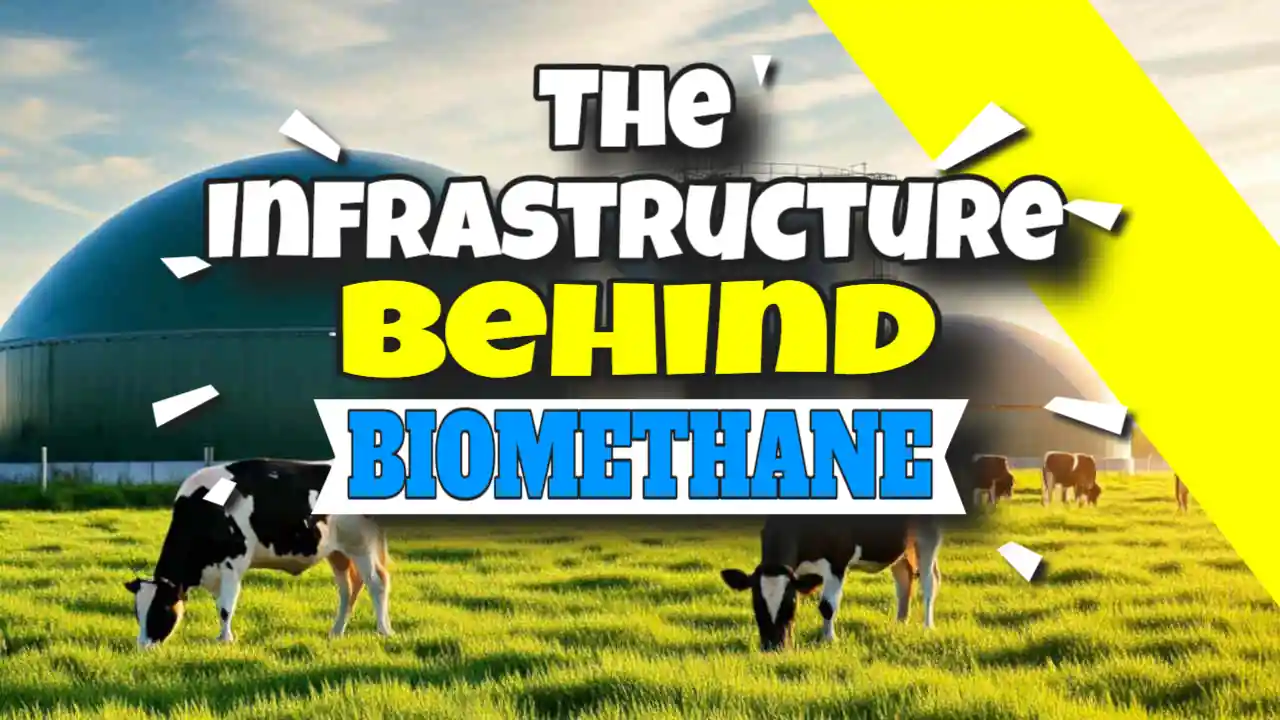What Makes Biomethane Possible: Its Infrastructure. Biomethane is rapidly transforming the renewable energy landscape, but how does it truly impact our environment and economy? This article provides a comprehensive look at the significance of biomethane, revealing its potential to revolutionize energy systems. Here are the key insights you’ll gain about this sustainable energy source.
What You Will Learn
- Biomethane is produced from the breakdown of organic materials, presenting a sustainable alternative to fossil fuels.
- The use of biomethane can significantly reduce greenhouse gas emissions, promoting a cleaner atmosphere.
- Biomethane projects enhance energy security by diversifying energy sources and supporting local economies.
- Compared to fossil fuels, biomethane has a lower carbon footprint and less environmental impact.
- Biogas, the precursor to biomethane, is generated through anaerobic digestion and is essential for its production.
- Utilizing biomass for biogas production maximizes energy yield and supports waste management efforts.
- Investing in biomethane infrastructure can lead to economic growth and job creation in local communities.
- The transition to biomethane supports climate change mitigation efforts and promotes a circular economy.
The Infrastructure Behind Biomethane: An Overview
Biomethane is making waves in the renewable energy sector! Its potential to provide clean energy solutions is increasingly recognized globally. To understand biomethane better, we must delve into its fundamental aspects, including the tecnologies used, and how it compares to traditional fossil fuels.
Biomethane Upgrading Technologies and Infrastructure: Technologies for Upgrading Biogas to Biomethane
Biomethane plants employ various technologies to upgrade biogas to biomethane quality. These technologies primarily focus on removing carbon dioxide (CO2) and other impurities from the raw biogas. The main upgrading technologies include:
- Water Scrubbing:
- Process: Biogas is pressurized and fed into a column where it comes into contact with water flowing in the opposite direction.
- Mechanism: CO2 is more soluble in water than methane, allowing for separation.
- Advantages: Simple process, low methane losses, simultaneous removal of H2S.
- Pressure Swing Adsorption (PSA):
- Process: Uses adsorbent materials (e.g., activated carbon, zeolites) to selectively adsorb CO2 under high pressure.
- Mechanism: Pressure is alternated between high and low to adsorb and then release CO2.
- Advantages: High methane purity, low power consumption.
- Chemical Absorption:
- Process: Uses chemical solvents (e.g., amine solutions) to absorb CO2.
- Mechanism: CO2 reacts with the solvent, which is then regenerated through heating.
- Advantages: High CO2 removal efficiency, suitable for biogas with high CO2 content.
- Membrane Separation:
- Process: Uses selective membranes that allow CO2 to pass through while retaining methane.
- Mechanism: Difference in permeability of gases through the membrane material.
- Advantages: Low energy consumption, compact design, easy scalability.
- Cryogenic Separation:
- Process: Cools and compresses the biogas to liquefy and separate CO2.
- Mechanism: Exploits different boiling points of methane and CO2.
- Advantages: Produces high-purity biomethane and liquid CO2 as a by-product.
After upgrading, the biomethane is compressed for transport and use:
- Compression: Multi-stage compressors increase gas pressure to 200-250 bar for storage in high-pressure tanks or injection into gas grids.
- Drying: Moisture is removed to prevent corrosion and meet gas grid specifications.
- Odorization: Odorants are added for safety, allowing leak detection in distribution systems.

The Role of Gas Grids and Storage Solutions
Gas grids play a crucial role in biomethane distribution:
- Transmission Networks:
- High-pressure pipelines transport large volumes of gas efficiently over long distances.
- Biomethane can be injected directly into the existing natural gas networks provided that it is constantly monitored for quality and it meets quality standards.
- Distribution Networks:
- Lower-pressure systems deliver gas to end-users.
- May require additional compression or pressure regulation for biomethane injection.
Storage solutions are essential for managing biomethane supply and demand fluctuations:
- Underground Storage:
- Depleted gas fields or aquifers store large volumes of biomethane.
- Provides seasonal storage capacity.
- Above-ground Storage:
- High-pressure tanks for short-term storage at production sites.
- Spherical or cylindrical vessels for larger volumes.
- Line-packing:
- Utilizes existing pipeline network capacity by increasing pressure during low-demand periods.
Importance of Biomethane Gas-to-Grid Injection Sites
Biomethane gas-to-grid injection sites are critical for integrating renewable gas into existing infrastructure:
- Injection Stations:
- Measure gas quality and flow.
- Compress biomethane to match grid pressure.
- Add odorants for safety
- If necessary increase the calorific value to ensure equivalence with natural gas.
- Quality Control Systems:
- Continuous monitoring of biomethane composition.
- Ensure compliance with grid operator specifications.
- Blending Units:
- Mix biomethane with natural gas to achieve consistent quality.
- Manage seasonal variations in gas demand and production.
- Remote Monitoring and Control:
- SCADA systems for real-time data collection and control.
- Enable grid operators to manage biomethane input efficiently.
- Reverse Flow Technology:
- Allows biomethane injection into lower-pressure networks during low-demand periods.
- Compresses gas for upstream injection into higher-pressure grids.
These injection sites enable decentralized biomethane production to contribute to the overall gas supply, supporting the transition to renewable energy sources within existing gas infrastructure.
Understanding Biomethane and Its Significance in Renewable Energy
First, let’s define biomethane. This renewable gas is produced through the breakdown of organic materials, such as agricultural waste, food scraps, and wastewater. As a result, it plays a crucial role in the energy transition by offering a sustainable alternative to fossil fuels.
In the renewable energy landscape, biomethane stands out for several reasons:
- Reduces greenhouse gas emissions: It captures methane that would otherwise be released into the atmosphere.
- Enhances energy security: By diversifying energy sources, biomethane contributes to a more resilient energy system.
- Supports local economies: Biomethane projects can create jobs and stimulate growth in rural areas.
Defining Biomethane and Its Role in the Energy Transition
Biomethane is essentially a purified form of biogas, primarily composed of methane. Its production contributes significantly to the quest for energy sustainability. By transforming waste into energy, biomethane showcases the potential of circular economies in the fight against climate change.
Moreover, biomethane can be injected into existing natural gas networks, thus facilitating its integration into the current energy infrastructure. This makes it a versatile option for various applications, including heating, electricity generation, and transportation fuels.
Comparing Biomethane to Fossil Fuels
When we compare biomethane to fossil fuels, the differences are striking. Biomethane is renewable, meaning it can be produced continuously without depleting resources. In contrast, fossil fuels are finite and lead to environmental degradation.
Some key points to consider in this comparison include:
- Carbon footprint: Biomethane has a significantly lower carbon footprint than fossil fuels.
- Environmental impact: The production of biomethane helps reduce pollution compared to conventional fossil fuel extraction and use.
- Energy efficiency: Biomethane can be produced locally, reducing the need for long-distance transport of fossil fuels.
Biogas and Its Relationship to Biomethane
To fully appreciate biomethane, we must understand its precursor: biogas. Biogas is generated through the anaerobic digestion of organic matter and consists mainly of methane and carbon dioxide. This process is vital for producing biomethane, as it serves as the foundation for its generation.
Biomethane can be derived from biogas through a purification process that removes impurities and carbon dioxide. This makes biogas a crucial contributor to the renewable energy landscape, as it can be transformed into a cleaner, more usable form of energy.
The Connection Between Biogas and Renewable Energy
Biogas is a key player in the renewable energy sector. As a source of energy, it can be utilized for various applications, such as heating, electricity generation, and even as a vehicle fuel. The connection between biogas and renewable energy is essential for reducing reliance on fossil fuels.
Here are some important aspects of this relationship:
- Waste management: Biogas production helps manage waste effectively by converting it into energy.
- Energy independence: Utilizing biogas promotes energy independence and security for communities.
- Environmental benefits: Biogas production reduces methane emissions from landfills and agricultural sectors.
Understanding the Role of Biomass in Biogas Production
Biomass is the organic material that serves as the feedstock for biogas production. This can include agricultural residues, food waste, and even energy crops specifically grown for energy production. The efficient use of biomass is essential for maximizing biogas yields.
Key types of biomass used in biogas production include:
- Agricultural waste: Leftover materials from crops can be used to produce biogas.
- Food waste: Leftovers from restaurants and households can contribute significantly to biogas production.
- Energy crops: Certain crops can be grown specifically for their high energy content and are often used as feedstock.
By efficiently utilizing biomass, we can enhance biogas production, thereby boosting the overall potential of biomethane as a renewable energy source.
Environmental and Economic Benefits of Biomethane Infrastructure
Biomethane infrastructure offers significant environmental benefits, making it a key player in the renewable energy landscape. One of the most impactful aspects is its ability to help reduce our carbon footprint. By capturing methane that would otherwise escape into the atmosphere from organic waste, biomethane systems actively work towards lowering greenhouse gas emissions.
Understanding how biomethane contributes to climate change mitigation is crucial. Transitioning from fossil fuels to biomethane not only lowers emissions but also plays a role in achieving carbon neutrality. Biomethane systems can significantly cut down greenhouse gases, providing a cleaner, more sustainable energy source for our communities.
Assessing the Carbon Footprint of Biomethane Systems
When we evaluate the carbon footprint of biomethane systems, we see a clear picture of their positive environmental impact. These systems are designed to capture and use methane, which is a potent greenhouse gas, thereby preventing it from entering the atmosphere. The shift to biomethane helps in achieving better overall environmental health.
- Biomethane can reduce CO2 emissions by up to 80% compared to fossil fuels.
- Using waste materials for biomethane production helps decrease landfill usage.
- Biomethane projects can lead to improved soil health through organic waste recycling.
With these benefits, it’s evident that investing in biomethane infrastructure is a step towards a sustainable future. Communities can help address climate change while also benefiting from cleaner air and healthier ecosystems.
How Biomethane Contributes to Reducing Greenhouse Gas Emissions
One of the standout features of biomethane is its ability to drastically cut greenhouse gas emissions. By utilizing organic waste and capturing methane, biomethane production turns a potential environmental hazard into a valuable energy source. This shift away from conventional fossil fuels not only helps in reducing emissions but also promotes a circular economy.
Moreover, biomethane production often results in a net-zero carbon cycle since the carbon emitted when using biomethane is offset by the carbon absorbed during the growth of the biomass. This balance is vital in addressing climate change effectively.
You Also May Like to Read Our Other Biomethane Articles Such as:
Economic Implications for Local Communities
Biomethane projects bring numerous economic benefits to local communities, helping to stimulate growth and create jobs. As these projects develop, they foster new employment opportunities in various fields, from engineering to waste management. This influx of jobs can greatly enhance the economic landscape of rural and urban areas alike.
- Creation of local jobs in construction and operation of biomethane plants.
- Boost to regional economies through increased business activities.
- Support for agricultural sectors by utilizing organic waste.
These initiatives don’t just create jobs; they also encourage investment in sustainable practices and contribute to long-term economic resilience. Communities can thrive by harnessing the potential of biomethane, leading to sustainable growth.
Job Creation and Economic Growth from Biomethane Projects
One of the most compelling aspects of biomethane initiatives is their potential for job creation. As the demand for renewable energy systems grows, so does the need for skilled workers to build and maintain these facilities. This not only provides employment but also encourages training and educational programs in the community.
Moreover, the economic ripple effect of these projects can lead to improved infrastructure and services. The increase in job opportunities often stimulates local businesses, creating a more vibrant economy that can sustain itself in the long run.
Comparison of Biomethane and Fossil Fuels
Biomethane significantly contributes to reducing greenhouse gas emissions and enhancing energy security compared to fossil fuels.
FAQs about Biomethane
1. What is biomethane?
Biomethane is a renewable gas produced from the breakdown of organic materials, primarily composed of methane, and serves as a sustainable alternative to fossil fuels.
2. How does biomethane impact greenhouse gas emissions?
Biomethane significantly reduces greenhouse gas emissions by capturing methane that would otherwise be released into the atmosphere, helping to lower overall carbon footprints.
3. What are the economic benefits of biomethane projects?
Biomethane projects create local jobs, stimulate economic growth, and support agricultural sectors by utilizing organic waste.
4. How does biogas relate to biomethane?
Biogas is generated through anaerobic digestion of organic materials and serves as the primary precursor for producing biomethane through purification processes.
5. Can biomethane be integrated into existing energy systems?
Yes, biomethane can be injected into existing natural gas networks, facilitating its integration into current energy infrastructures for heating, electricity generation, and transportation fuels.





Leave a Reply